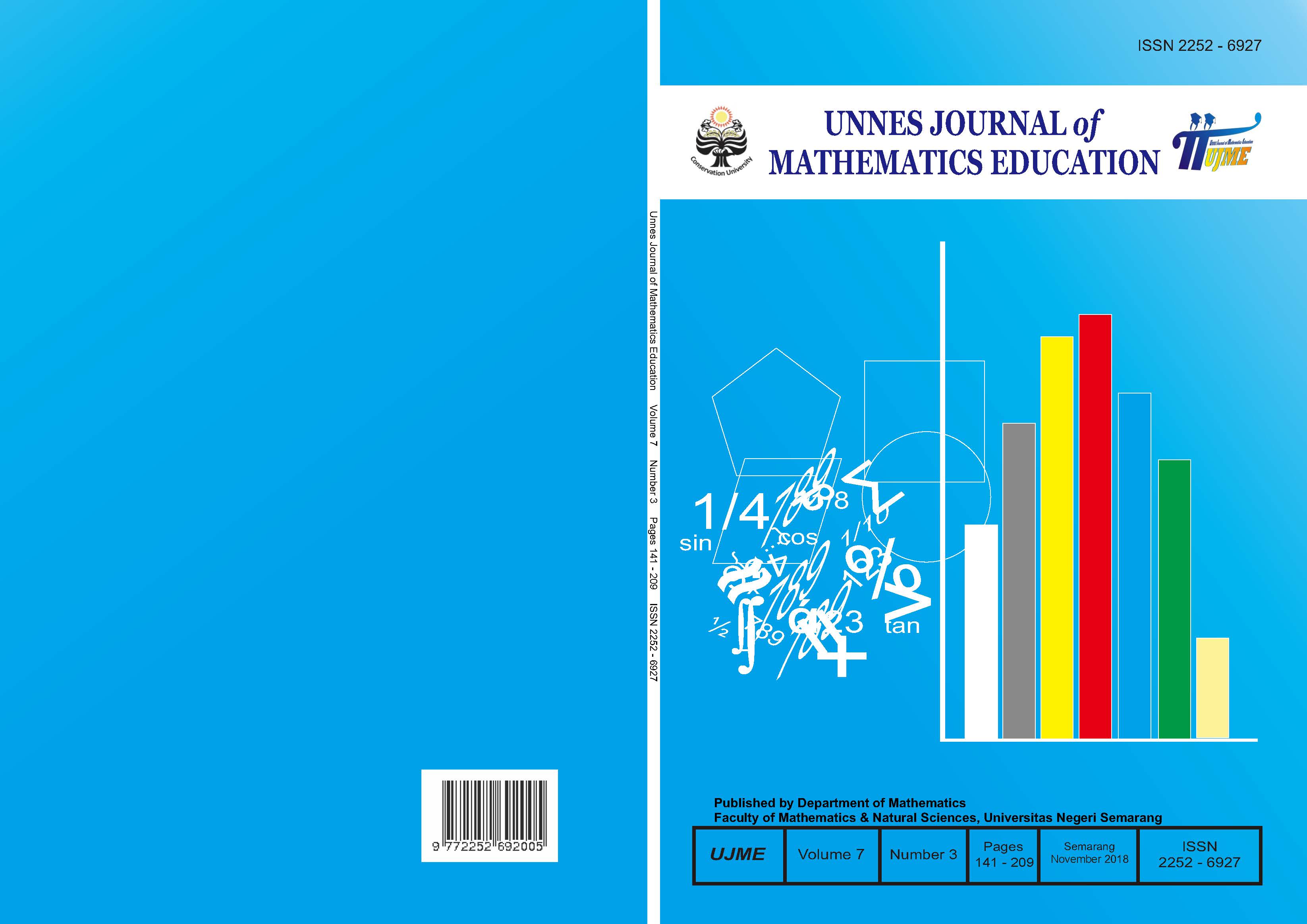Problem solving skill through think pair share model with murder approach viewed from learning interest of tenth grade students
##plugins.themes.academic_pro.article.main##
Abstract
This research focuses on problem-solving capability through Think Pair Share model with MURDER approach viewed from learning interest of the students. TPS learning with MURDER approach was conducted through three phases of TPS namely Think, Pair, and Share. This research aims to testthe completeness of problem-solving through TPS model with MURDER approachand to describe the problem-solving capability through TPS model with MURDER approach viewed from students’ learning interest.This research usedmixed methods with concurrent embedded design. The samples of this research weretenth-grade students of AP (experimental class) andtenth grade TP A (control class) of State Vocational High School 2 Rembang who were chosen through random sampling technique. The quantitative data collection technique used test, while qualitative data collection used triangulation technique. Sample selection on qualitative research used purposive sampling technique. The qualitative datawere analyzed by usingnormality, homogeneity, equality of two means, t, and z tests. Qualitative data were analyzed by using data validation test, data reduction, data presentation, and verification andconclusion drawing. The results of the research showedthat the (1) problem-solving capabilities of the students through TPS model with MURDER approach has reached individual and classical completeness, (2) the problem solving capabilities of the students through TPS model with MURDER approach was better than the problem solving capabilities of the studentsthrough expository learning model, (3) students with high learning interestcould fulfill all problem solving capability indicators, (4) students with moderate learning interestcould fulfill fourproblem solving capability indicatorsbut they tend to be lessthorough, and (5) students with low learning interestwere less able to fulfill appropriate strategies application indicators to solve the problem.
##plugins.themes.academic_pro.article.details##
References
Alfurofika, P.S., S.B. Waluya, & Supartono. 2013. Model Pembelajaran Jigsaw dengan Strategi Metakognitif untuk Meningkatkan Self-Efficacy dan Kemampuan Pemecahan Masalah. Unnes Journal of Mathematics Education (UJME), 2(2).
Ardiani, T.E., S.B. Waluya, & A.W. Kurniasih. 2016. Keefektifan Implementasi Pembelajaran CRH Berbantuan Kartu Masalah dalam Peningkatan Kemampuan Pemecahan Masalah dan Disposisi Matematik Siswa SMP Kelas VII. Unnes Journal of Mathematics Education (UJME), 5(2).
Arifin, Z. 2012. Evaluasi Pembelajaran. Bandung: Remaja Rosdakarya.
Arikunto, S. 2013. Dasar-Dasar Evaluasi Pendidikan. Jakarta: Bumi Aksara.
Behzadi, M.H., F.H. Lotfi, & N. Mahboudi. 2014. The Study of Teaching Effective Strategies on Student's Math Achievements. Mathematics Education Trends and Research (METR), 2014(40): 1-8.
Graceful, O. & A.L. Raheem. 2011. Cooperative Instructional Strategies and Performance Levels of Students in Reading Comprehension. International Journal of Science, 3(2):103-107.
Jozetani, L.K., A. Yarmohamadian, & M. Malekpur. 2015. Effectiveness of MURDER Method on the Improvement of Academic Performance of Children with Spelling Learning Disorder. Magazine of E-learning Distribution In Academy, 6(3): 1-9.
Kpolovie, P.J., A.I. Joe, & T. Okoto. 2014. Academic Achievement Predictiont: Role of Interest in Learning and Attitude toward School. International Journal of Humanities Social Sciences and Education (IJHSSE), 1(11):73-100.
Kuncoro, K.S., A. Suyitno, & E. Sugiharti. 2013. Keefektifan Pembelajaran TPS Berbantuan Mouse Michief terhadap Hasil Belajar Siswa. Unnes Journal of Mathematics Education (UJME), 2(2).
Lestari, I. 2013. Pengaruh Waktu Belajar dan Minat Belajar terhadap Hasil Belajar Matematika. Jurnal Formatif, 3(2): 115- 125.
Lestari, K.E., & M.R. Yudhanegara. 2015. Penelitian Pendidikan Matematika. Bandung: Refika Aditama.
Marlina, L. 2013. Penerapan Langkah Polya dalam Menyelesaikan Soal Cerita Keliling dan Luas Persegi Panjang. Jurnal Elektronik Pendidikan Matematika Tadulako, 1(1).
Masela, A., & M.I. Marasabessy. 2016. Penerapan Model Pembelajaran Kooperatif Tipe MURDER (Mood, Understand, Recall, Detect, Elaborate, Review) terhadap Hasil Belajar dan Aktivitas Siswa Materi Peluang Kelas XI IPA SMA Advent Maluku. Bimafika, 8:25-30.
Muhlisin, M. Asikin, & Kartono. 2013. Keefektifan Pembelajaran Model TPS Berbantuan GSP pada Pencapaian Kemampuan Pemecahan Masalah. Unnes Journal of Mathematics Education (UJME), 2(1).
Mustaqim, B., Riyadi, & I. Sujadi. 2013. Eksperimentasi Model Pembelajaran Kooperatif Tipe Think Pair Share (TPS). Jurnal FKIP UNS, 1(3).
Nataliasari, I. 2014. Penggunaan Model Pembelajaran Kooperatif Tipe Think Pair Share (TPS) untuk Meningkatkan Kemampuan Penalaran dan Pemecahan Masalah Matematis Siswa MTs. Jurnal Pendidikan dan Keguruan, 1(1).
Novianto, G. & Subkhan. 2015. Pengaruh Minat Belajar, Motif Berprestasi, dan Kesiapan Belajar terhadap Prestasi Belajar Siswa Kelas XI IPS pada Mata Pelajaran Akuntansi di SMA Negeri 1 Subah Tahun Pelajaran 2013/2014. Economic Education Analysis Journal, 4(2).
Pandya, S. 2011. Interactive effect of cooperative learning model and learning goals of students on academic achievement of students in mathematics. Mevlana International Journal of Education (MIJE), 1(2): 27-34.
Pramadita, A.A., Mashuri, & R. Arifudin. 2013. Keefektifan Model Pembelajaran Course Review Horray terhadap Hasil Belajar dan Minat Belajar. Unnes Journal of Mathematics Education (UJME), 2(2).
Rahayu, D.P., Supriyono, & S.B. Waluya. 2017. Analisis Kemampuan Pemecahan Masalah Matematika Siswa SMK Kelas X Boarding School Ditinjau dari Gaya Belajar. Unnes Journal of Mathematics Education (UJME), 6(1).
Roosilawati, E. 2013. Karakteristik Kemampuan Bernalar dan Memecahkan Masalah Peserta Diklat Peningkatan Kompetensi Guru Kelas Sekolah Dasar. Semarang: LPMP Jawa Tengah
Santosa, N., S.B. Waluya, & Sukestiyarno. 2013. Kemampuan Pemecahan Masalah pada Pembelajaran Matematika dengan Strategi Master dan Penerapan Scaffolding. Unnes Journal of Mathematics Education (UJME), 2(2).
Setiawan, D., S.B. Waluya, & Mashuri. 2014. Keefektivan PBL Berbasis Nilai Karakter Berbantuan CD Pembelajaran terhadap Kemampuan Pemecahan Masalah Materi Segiempat Kelas VII. Unnes Journal of Mathematics Education (UJME), 3(1).
Siagian, R. 2012. Pengaruh minat dan kebiasaan belajar terhadap prestasi belajar matematika. Jurnal Formatif, 2(2): 122-131.
Siswanto, B., S.B. Waluya, & Wardono. 2013. Peningkatan Kemampuan Pemecahan Masalah Melalui Pembelajaran IDEAL Problem Solving – Konstruktivisme Berorientasi Pendidikan Karakter. Unnes Journal of Mathematics Education (UJME), 2(2).
Syah, M. 2008. Psikologi Pendidikan dengan Pendekatan Baru. Bandung: PT. Remaja Rosdakarya.
Utami, R., Kartono, & S.B. Waluya. 2015. Pencapaian Kemampuan dan Keterampilan Pemecahan Masalah Matematika Siswa Kelas VIII pada Pembelajaran Model CPS dan TAPPS. Unnes Journal of Mathematics Education (UJME), 4(3).
Warouw, W.S. 2016. Penerapan Model Pembelajaran Kooperatif Tipe MURDER untuk Meningkatkan Hasil Belajar Siswa pada Materi Panjang Garis Singgung Persekutuan Dua Lingkaran di Kelas VIII SMP N 6 Palu. Aksioma Jurnal Pendidikan Matematika, 5(2).
